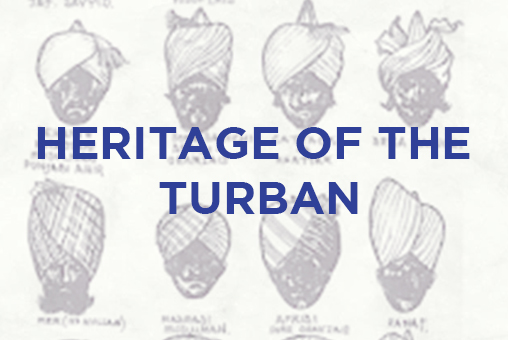The turban is commonly associated with the Sikh identity. Actually the turban has been used not only in India but throughout the world for thousands of years. The turban has been worn by religious people, royalty and used in fashion. The turban has been called by different names in different countries. In Persian, it is called “Dulband” or “Sarband”; Turkish “Tulband”; Italian, Spanish, Portugese “Turbante”; Dutch “Tulbans”; Romanian “Tulipan”; French “Turbant”; English “Turban”; and in ancient Egyptians “pjr”. In India it is called “Pag” or “Pugri”, the name that probably came from “pjr” and the Sikhs call it “Dastar”. Europeans used the turban for fashion as early as fifteenth century. There is an oil painting in the National Gallery at London by Jan Van Eyck with a caption “a man in turban” which dates back to 1433 AD.
The Turban has been a symbol of purity as is evident from this text from the Old Testament. Looking at Joshua dressed in dirty clothes, angel of God said: Take off his dirty clothes, cloth him in splendid robes of State and put a clean turban on his head. “I have taken away your inequity from you.” (Zechariah 3:4-9)
In Islam Prophet Muhammad said:
“The turban is a frontier between faith and unbelief.”
“Wear turbans, for thus you will gain in generosity.”
“Wear turbans and thus distinguish yourselves from the people who came before you.”
“My community shall not fall away so long as they wear turban.”
“At the day of the judgment, a man shall receive a light for each turn of the turban round his head.”
The Sikhs call their turban “Dastar”. It is also called “Pugri” or “Pag”. The Sikhs do not cut their hair. They tie their hair on the forehead in a knot called “Jurha”, and the turban is used to cover the hair. All Sikh Gurus kept their hair uncut and wore the turban. It is worth mentioning that at that time Moguls were ruling India, who dictated that only Muslims and Hindu Rajputs who were employed in their court were allowed to wear the turban. As a sign of slavery rest of Indians were forbidden from wearing turban which was replaced by cap (Topy). Sikh Gurus and Sikhs did not follow the dictate and continued wearing Dastar.
Though others have forgotten about the importance of the turban, Sikhs and some Muslims continued and are still wearing the turban. Muslims wrap the turban in a circular style, or around a conical or spherical cap called Kalansuwa. Afghan men wrap the turban in a circular style with one end hanging loose over the shoulder. The turban of Baloch Sardar of Balochistan consists of white fine cotton wrapped around the head. Its tail, instead of hanging loosely at the back, is at one side of the turban and usually brought down loosely under the chin and then up on the other shoulder, sometime tucked in the folds of the turban, thus framing the face of the person in folds of white cotton. The turban tail is also used to cover one’s face during dust storms in the desert. The Iranian religious leader Ayatollah Khomeini wore a black or white turban wound in a circular style. The Palestinian leader Yasser Arafat wore the Kaffiyeh, which is not a turban. It is a diagonally folded rectangular piece of cloth draped over the head. Men in Palestine, Jordan, Saudi Arabia and Arab Persian Gulf states wear Kaffiyehs. Palestinians wear black and white Kaffiyeh and Jordanians wear red and white Kaffiyeh. Nomadic tribes of Africa and Rajasthan living in deserts use the turban to keep sand out of their faces. Sometimes a person’s tribe can be identified from the colour of the turban.
Look of Sikh Dastar is different from others. Guru Gobind Singh’s warrior Sikhs, Nihangs wear Dastar called Dhamala /Dumalla #1, which has the “Chand Tora” with the metal wire around the Dastar. A variation of the Dhamala Dastar #2 is without the Chand Tora. Another smaller and simpler variation of the above two Dhamala Dastar is Dhamala #3. The Sikhs these days wear conical peaked turban and is always tied to fit the shape of the head. Sikh Dastar (Turban) is an article of Faith, a Spiritual Crown, which cannot be removed in public, except in the privacy of the house.
Author : Dr. Kala Singh
This Page Is Created For Informative Purposes And Is Opinion-Based. Our Intentions Are Not To Offend Or Upset Anyone. If You Believe This Is The Case, Please Share Your Feedback And/Or Suggestions By Emailing Us At [email protected]. Thank You.




